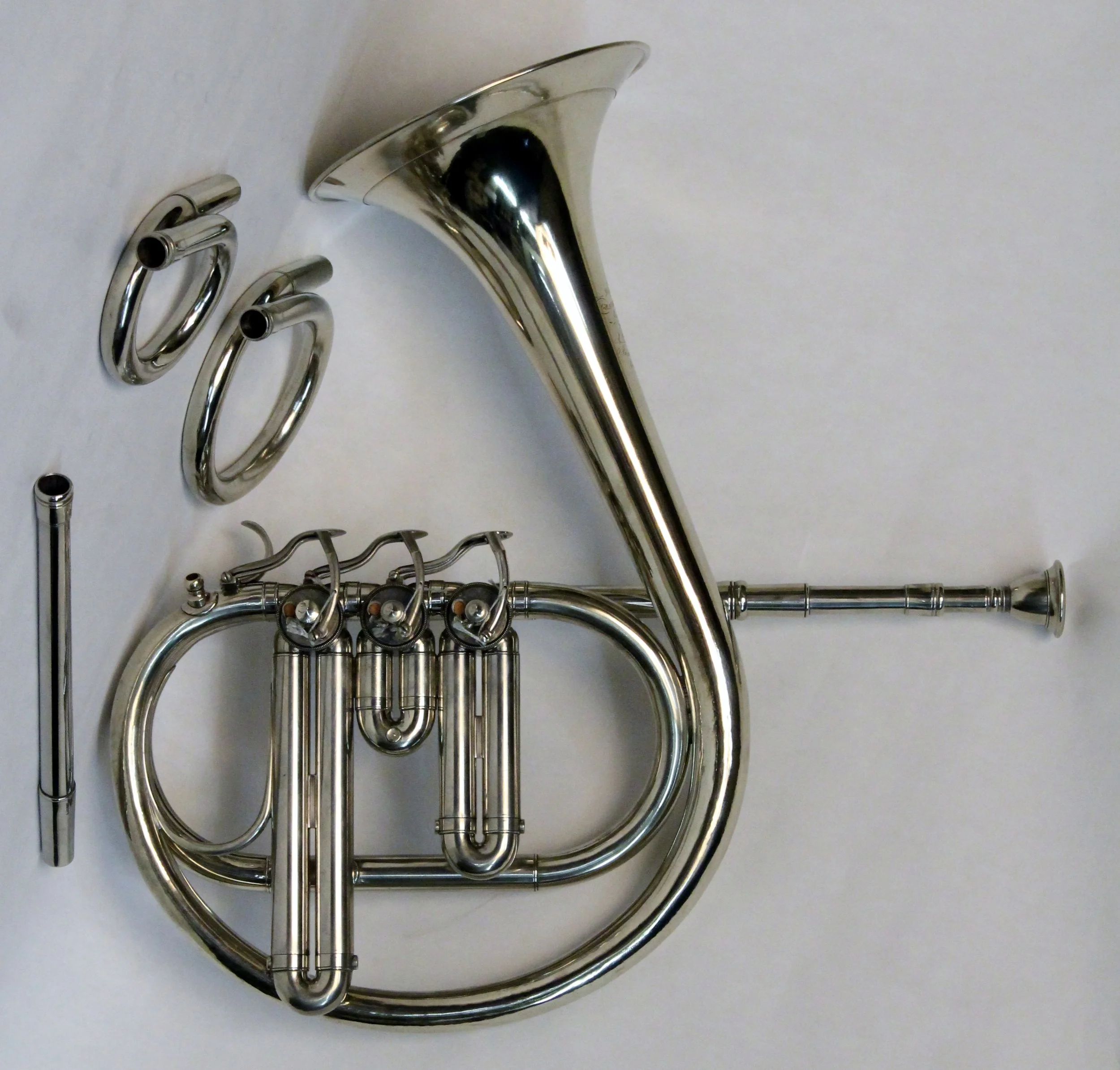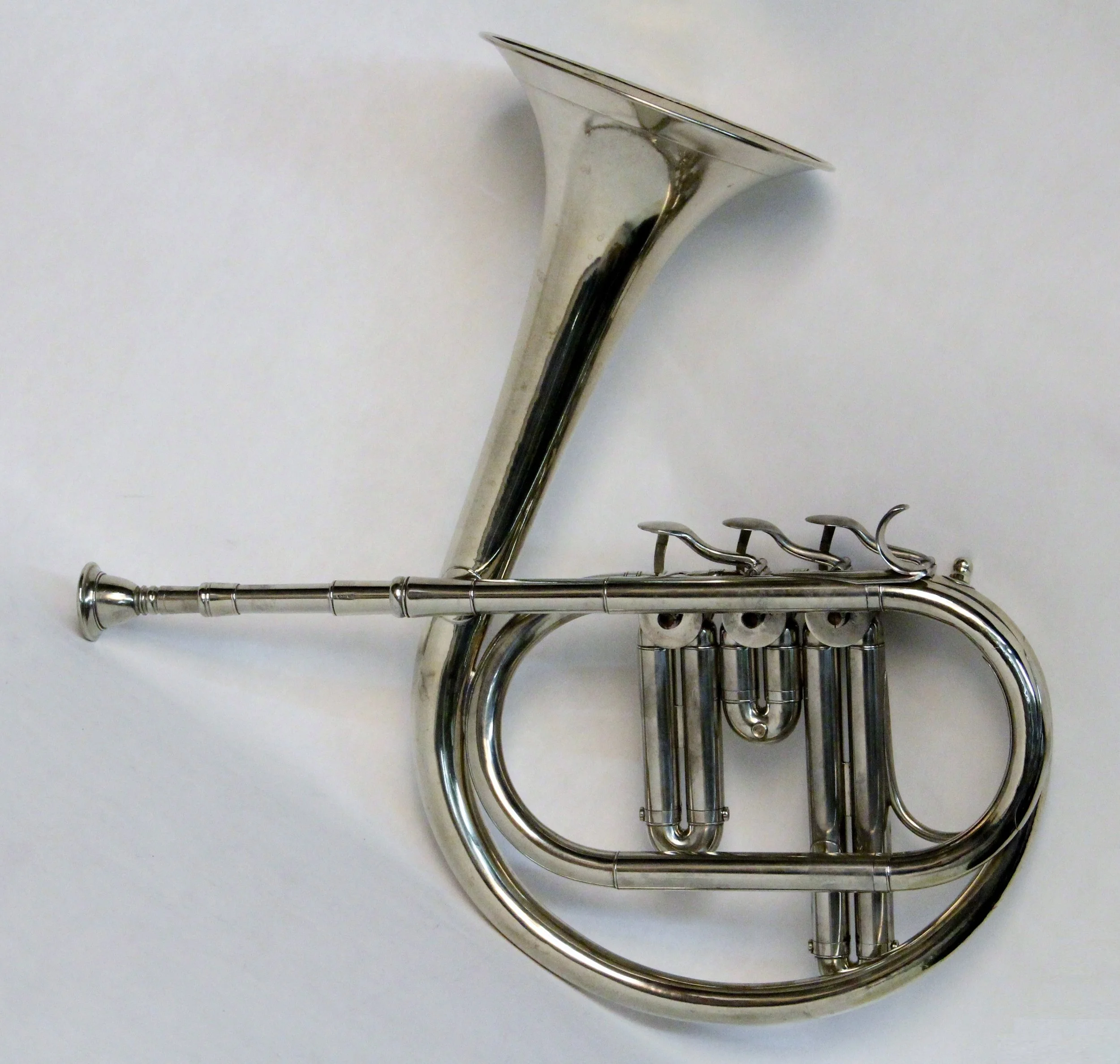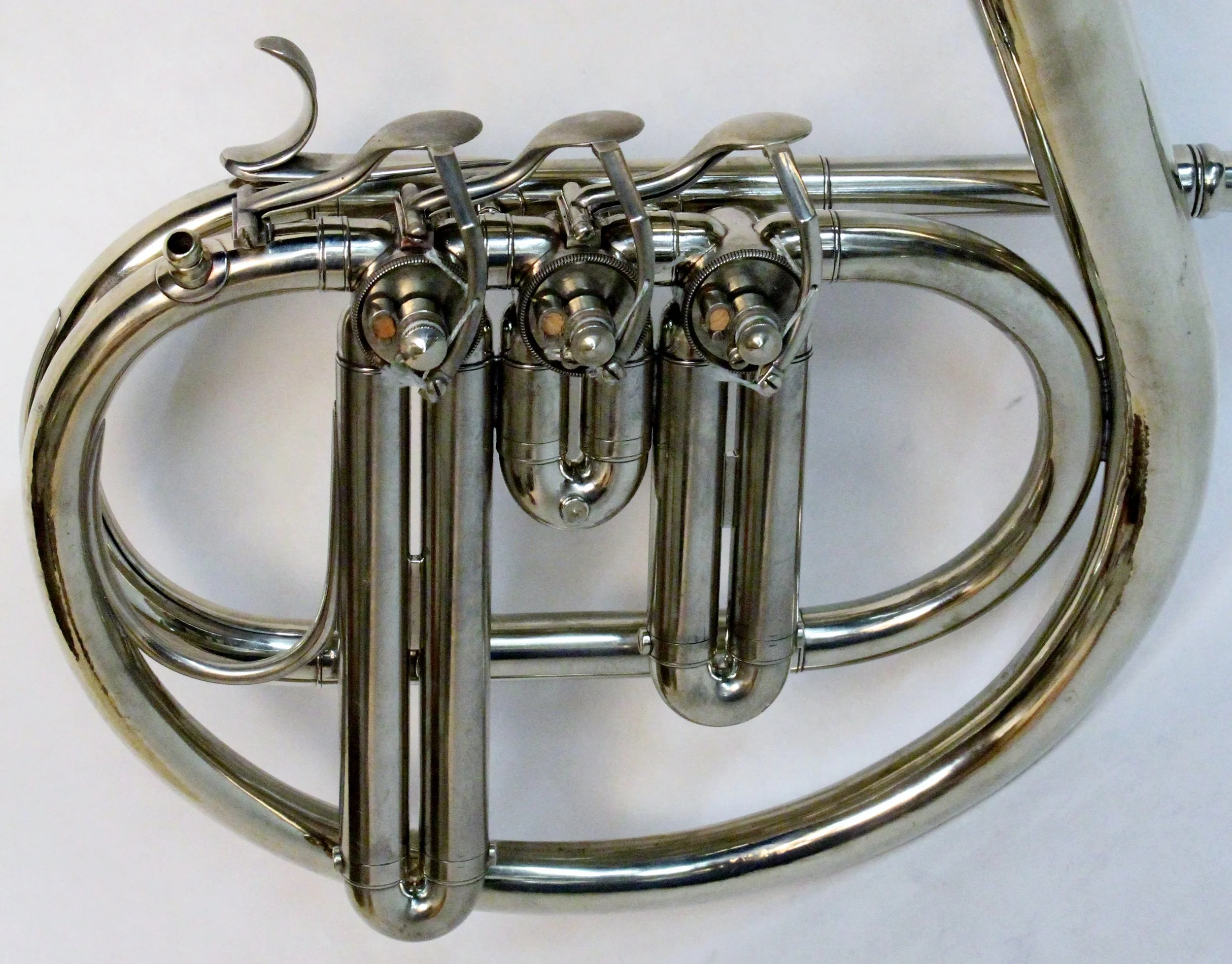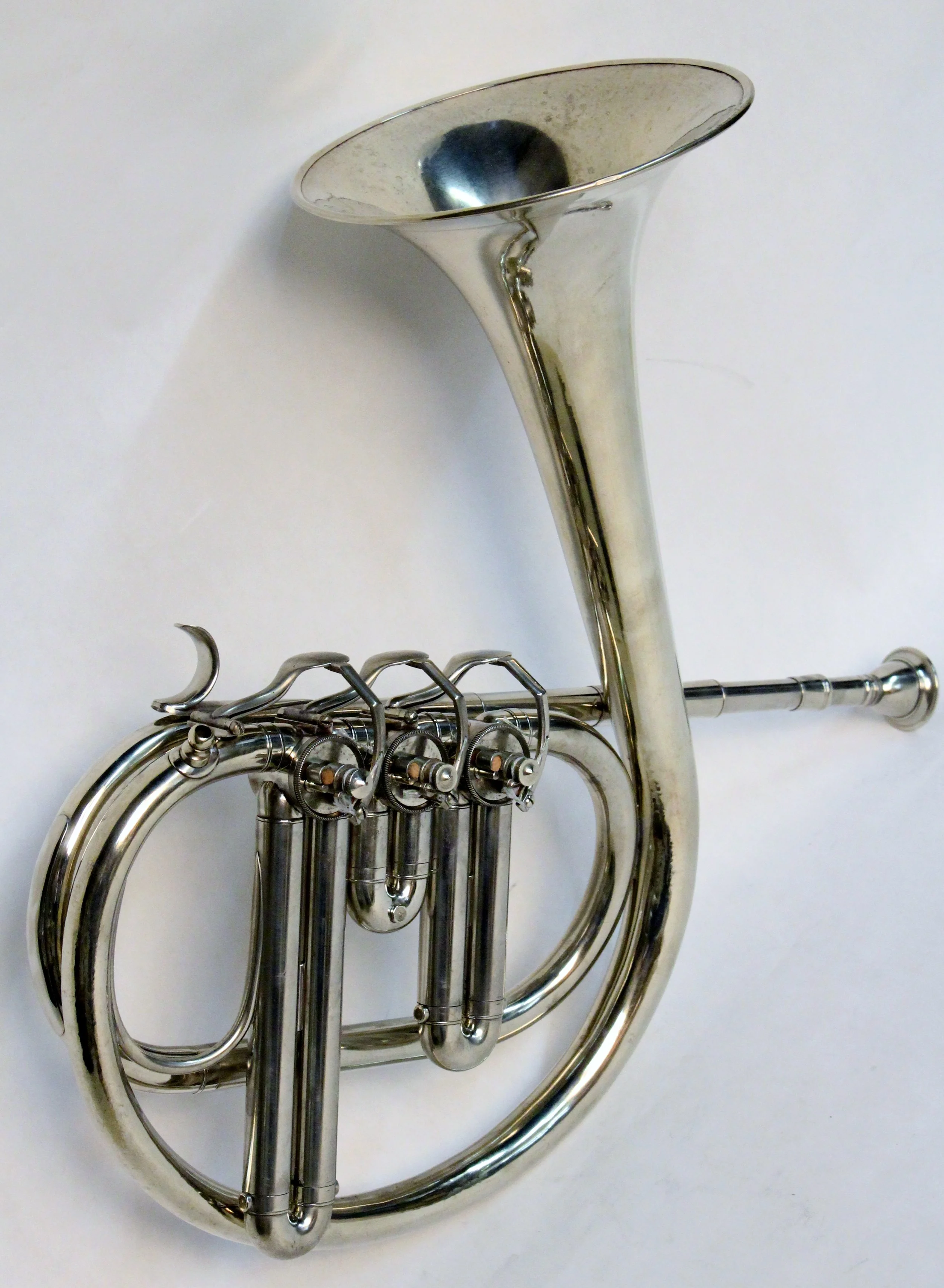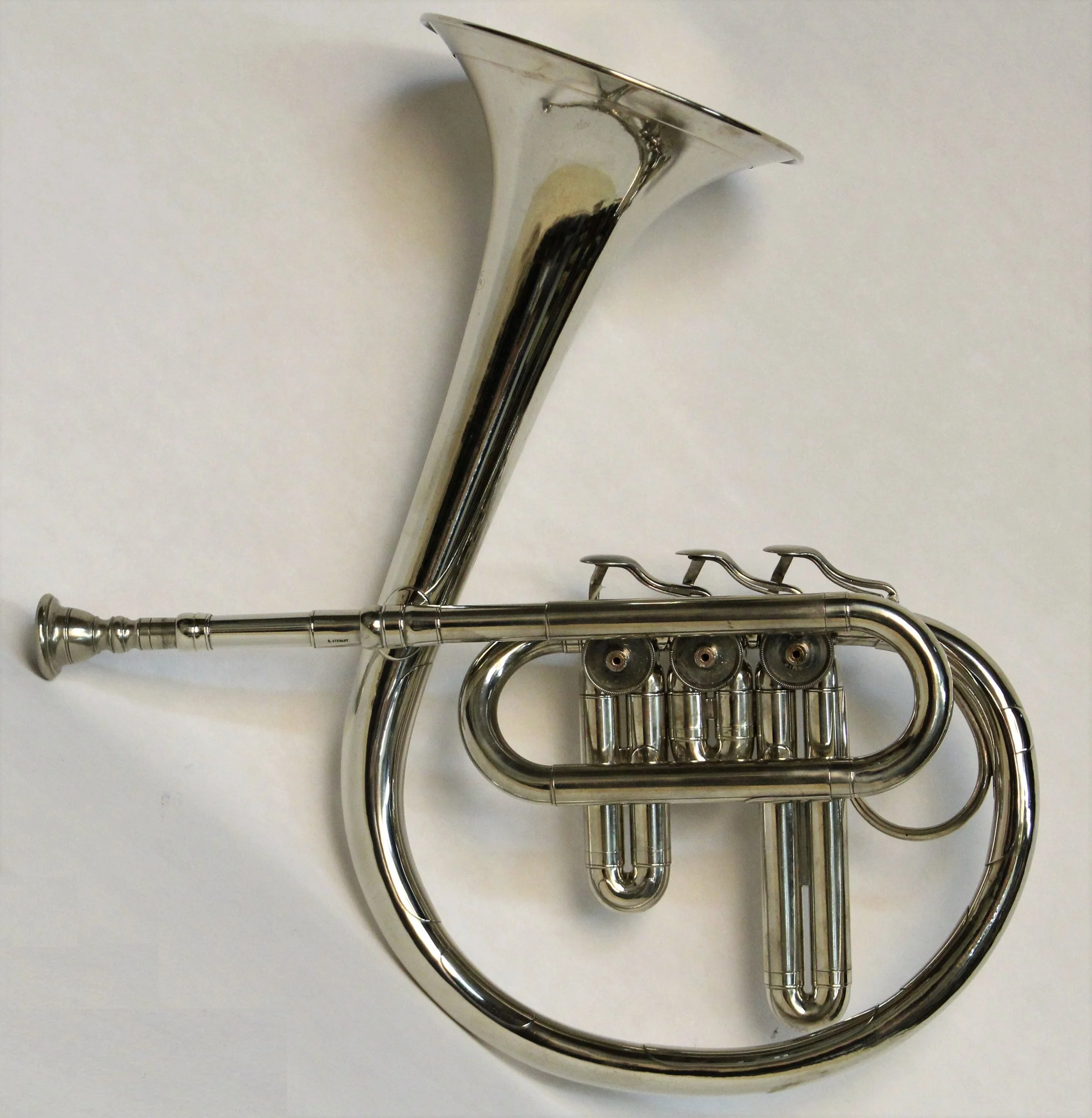Graves & Co. Circular Cornets in Bb and C
This very rare Graves & Co., Boston, circular Bb cornet was found in a thrift shop at a price that is less than you would expect to pay for a student model cornet in the same condition. It was certainly a stroke of good fortune for its new owner Justin Lange, a medical student in central Missouri, who enjoys searching out antiques in such places and immediately recognized this as something very old and unusual. He was able to find me though Internet searches and asked me to restore it for him.
Click on image below for larger views.
There really isn't anything new to present here in the restoration process. Having specialized in early US made brass instruments, I was able to recognize the existence of original parts and to replicate those that were missing very accurately. Mostly, I wanted to share my enthusiasm for the quality of design and workmanship in this wonderful instrument. It had been battered and abused, even splitting tubing and wrenching joints loose, but I didn't have to deal with previous amateur repair attempts that so often break my heart and make my work so difficult.
I was very excited to see that the crooks and mouthpiece, that are most often lost, were the originals made by Graves for this instrument. There is only one other circular Bb cornet by Graves known and two in C. The missing Bb and A mouthpipe shanks were relatively easy to replicate from my experience with other similar instruments. The original crooks lower the pitch to Ab and G.
More interesting, is a discussion of the history related to this cornet. Just the engraving starts to tell us a story, but immediately makes us ask additional questions. It appears that all the engraving was done at the time that it was made for the original owner, J.P. Fox of Mariposa, California. Mariposa was founded as a mining camp before 1850, but by 1854 had its own courthouse. Presumably, the town was stable enough by this time to support a town band, so it isn't too surprising that high quality instruments might be in demand.
My first impression of this instrument, with very wide tuning slide crook and return crook, led me to speculate that it was made in the mid-1850s, when the style was becoming quite popular and we know that Graves was enjoying success in their Boston shop. After completing the restoration, I decided that this instrument was important enough to make a measured, full size drawing. The bore through the valves measures .454", which is larger than typical for the 1850s (the Saxhorn and cornopean era), and also unusual is that the tuning and mouthpipe crooks are tapered. The fixed portion of the mothpipe and upper tuning slide tube are cylindrical at .428".
I then measured the bell diameters at one inch increments, the rim measuring 5". I've measured many bells in this way that I deemed important, so that I can make quick comparisons. This is how I determined that Bb cornets made by E.G. Wright and Boston Musical Instrument Manufactory were copies of those made by Courtois in Paris. Most Bb cornets made in Boston before 1860, that I have been able to examine closely, have wider bell tapers and flares that seem more closely related to English cornopeans or German band cornets and trumpets or the singular Graves & Co. Bb cornet with bell over the shoulder that has a very skinny bell flare.
In this case, however, the bell seems to mimic those by Courtois, making me think that it was made later than my first guess. But this is a guess as well, and insinuates the question of when a Boston maker first copied Courtois or Besson cornets. I have not been able to determine this, but it was by the early 1860s and by that time became extremely popular in the best Bb cornets. Knowing that most of the earliest examples were made by Wright, I had speculated that it was in that shop that this was first done.
Interestingly, Graves & Co. shared Wright's shop in 1856 through 1859 and again in the late 1860s. This data can't tell us much, but I'm inclined to make a guess as to the date of this cornet to be no later than the mid-1860s. I haven't been able to find much history of the city of Mariposa for these years, but I would assume that it was still a viable small town (the population today is still only just over 2000).
The brass band movement was booming throughout the US in these years and even some of the smallest towns had civic bands. We don't know how the demand for new instruments for bands being recruited and formed for the war effort would have effected the availability of cornets to be sent on ships around the horn to San Fransisco. This may change the calculation and more data about the shift to French style cornets may alter my guess, again, to the earlier years. I'm hoping that as we learn more in the future, a few of these questions will be answered.
Indeed, a few years later a small bit more evidence came my way in another very similar Graves circular cornet, this one pitched primarily in C. It is similarly complete in preservation, retaining its original tuning slides for C and Bb, the C/Bb shank (badly damaged), crooks for Ab and G and also the very deluxe original case. The case is exceptionally well preserved, including the leather thongs that hold the two crooks and extra tuning slide. Missing is the original mouthpiece (although it came with 4 non-original mouthpieces from the period) and mouthpipe shank and/or bits for A.
This cornet surfaced in Oxford, Massachusetts and was purchased by an antique dealer from Newtonville. The express labels on the case indicate that it likely spent its entire existence in Boston and central Massachusetts. It has similar dimensions as the Bb version through the mouthpipe, tapered tuning crook, although the valve bore is slightly larger at .457". The bell flare, again, a close copy of those by Courtois, but I believe that this one can be dated more accurately.
If you study the 7th and 8th photos above, you will see that this one has a variation in the valve mechanism. There are no external valve stop corks, instead, they are fitted inside the back bearing plate, with a rectangular post on the backs of the rotors that strike against them. In the much more common style used by Graves and seen in the Bb cornet, the corks are fitted into two "C" shaped holders on the stop arms and strike against a post on the bearing plate. Only the front bearing plate is removable for cleaning and maintenance, compared with those in the C cornet in which the back plate comes off in order to install and adjust the corks for valve alignment. In both cases, the valves have alignment marks on the back bearings and rotor bearing ends.
What makes this difference in design so important is that there is only one other Graves instrument that I know of with this design and it has a known date of manufacture. It is an Eb valve bugle (flugelhorn or Saxhorn) made of Sterling silver that was presented to Charles H. Stoes by the members of the Stoes Silver Cornet Band, Danville, Pennsylvania, in 1857. Being the only two known examples would lead us to believe that Graves only made this mechanism for a very short time and I would assume this C cornet to have been made in the same year.
Not only is it important to be able to determine when any historical instrument was made, but I am especially interested in the origin of the Boston made copies of Courtois cornets. This is the earliest dateable example of this type, but as I stated above, there is no way of knowing that the Bb cornet was made before or after this one. Of course there are other instruments out there that I haven't been able to measure, such as one very early circular Bb cornet by E.G. Wright in Mark Elrod's collection that almost certainly pre-dates these two, probably made before 1855, and has a bell flare that appears very similar to these. So it may be Wright that first made this style of cornet after all. Also, we can't know for sure if Graves' production of these cornets does not pre-date the Bb cornets with bells over the shoulder that are smaller dimensions through the flare, but I would guess that it was considered inferior and dropped when this design was introduced.
Also interesting are the markings on the valve slides made by the original owner, indicating how far to pull each slide when changing crooks. The lines appear to be the correct lengths for playing in Bb, A, Ab and G, agreeing with the crooks supplied. I am always curious how often the lower crooks were used and these lines seem to indicate that it was often enough for this player to desire this convenience. These marks are also present on the slides in the D.C. Hall Orchestra cornet featured elsewhere on this site, which plays in the same five keys.


